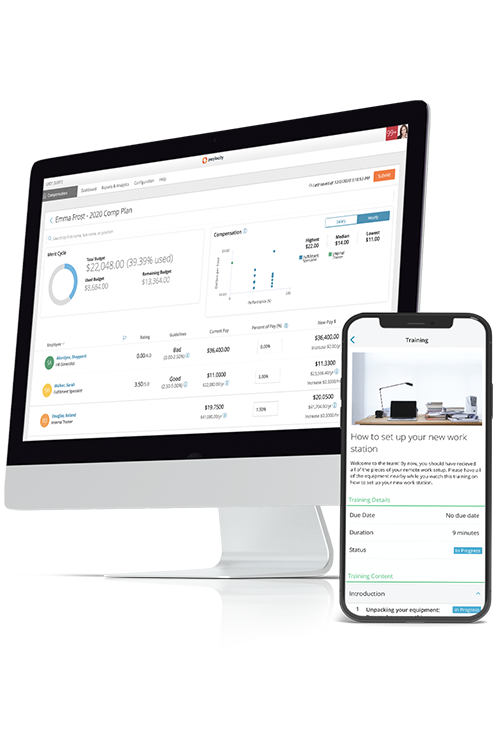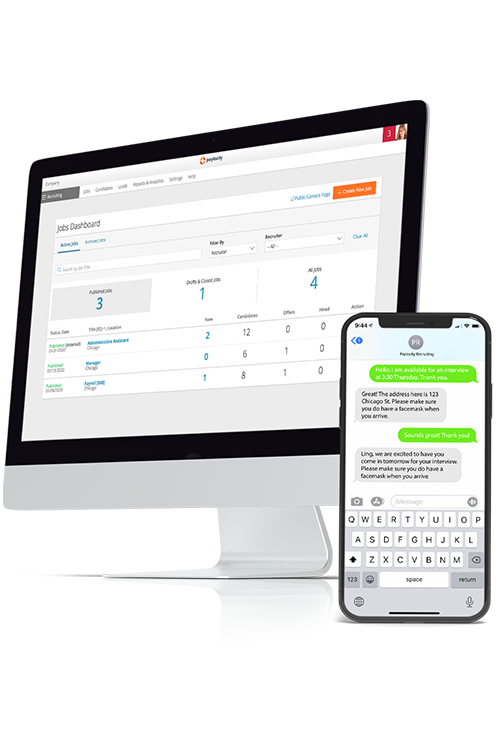Related Learning

Onward and Upward! How Internal Mobility Benefits a Company
It’s a tough job market out there…for employers.
With unemployment rates at record lows, top professionals in many industries can afford to be picky about who they work for.
How can employers compete? Well, start by looking from within.
The following guide explores how your business can take advantage of the skills your people already possess, and how you can create an internal mobility policy that helps your organization thrive.
What is Internal Mobility?
Internal mobility is the capacity for employees to move to a different role within your organization. Unfortunately, many businesses neglect improving this organizational trait. Their hiring policies are directed solely toward finding the perfect external candidate.
But when you’re competing for top talent, you can’t always find someone who’s ready to hit the ground running, particularly for roles requiring a high degree of skill. And even if you can, that candidate will likely need some time to get oriented with your processes and integrated into the company culture.
This conundrum alone makes it worthwhile to explore what prioritizing internal mobility as an expected part of the employee lifecycle can do for your business.
What are the Different Types of Internal Mobility?
Internal movement in a work setting can happen in various ways:
- Promotion: internal upward mobility as a reward for good performance.
- Demotion: internal downward mobility, often because performance is lacking. But it can also be voluntarily if an employee wants to reduce their work commitments.
- Lateral mobility: taking a role in a different department at a similar level of seniority.
- Project-based mobility: moving to a different role temporarily to deliver a particular project.
Why is Internal Mobility Important?
As of September 2023, the unemployment rate in America was 3.8%, close to the historical low of 2.5% in May 1953.
In other words, it’s not an employer’s market.
Businesses that don’t look inward for possible candidates are likely to struggle to fill all their vacancies. At the very least, they may have to spend a lot more time and effort finding and enticing external candidates.
But that’s not all. There’s also the question of retention. If you want to hold on to your best people, and avoid recruiting in the first place, offering internal opportunities is an excellent approach.
Let’s take a closer look at some of the main benefits of prioritizing internal mobility in your business.
5 Benefits of Internal Mobility
Aside from helping a company navigate a challenging job market and maintaining low employee turnover, a robust internal mobility plan has many other advantages for the organization.
- Lower hiring costs: Giving roles to internal candidates means you don’t have to bear the usual costs of recruiting external ones. Empowering internal candidates to apply for roles keeps key HR metrics like cost to hire and time to hire looking healthy.
- Improved employee engagement: When your employees know there are internal opportunities available, they can see a future for themselves within your organization. This gives them confidence that their skills will be appreciated over the long term.
- Better staff retention: Your best people are more likely to stick around if you can offer them new challenges. Moreover, if they're happy at work and just want to advance, they'll likely prefer a promotion or lateral move instead of the headache of a job hunt.
- Full use of skills: Your employees may have skills they don’t use in their current roles, while others may be keen to learn new ones. Being able to fine-tune training opportunities according to the needs of vacant roles instead of hiring someone new is a hallmark of efficient talent management.
- Boosted Employer Brand: For most businesses, internally filling every vacant role is impossible. But, a company with a robust internal mobility policy shows it cares about its people. This makes the organization more appealing to external candidates looking to develop their careers.
5 Internal Mobility Best Practices You Need to Follow
When putting your program in place, use the following best practices to help maximize the benefits the program will eventually provide:
1. Draw up Your Strategy
Before getting into the nitty gritty, make sure you and all other involved stakeholders have a clear, shared strategy in mind. Explain how your internal mobility policy will exist in your workplace and the impact you expect it to have.
Your exact strategy will depend on your organization’s specific needs, but might include:
- Identifying internal mobility KPIs, such as what percentage of employees should move to a new internal role every year
- Investigating and addressing any skill gaps in your workplace
- Creating a platform for individual employees to learn about and apply for available opportunities
- Training managers to identify and encourage suitable candidates for internal moves
2. Establish Clear Career Development Paths
Career development doesn’t need to be left to chance. Creating and implementing a career pathing strategy will create a more formal structure for internal mobility throughout your organization.
This will, in turn, give you an excellent foundation for mapping career development opportunities and more prescriptive recommendations for how employees can move up or laterally within your organization.
For maximum impact, synthesize your career pathing framework within each employee’s individual development plan. This way, each employee is aware of the opportunities available to them and can chart concrete next steps for advancement (if they wish).
3. Support Middle Management
Your middle managers are your eyes and ears, so for your mobility program to work, they need to have support recognizing and nurturing talented individuals.
Make skills assessment training mandatory for these managers to ensure they know how to spot valuable skills not immediately relevant to an employee’s current role. Being able to identify skills that could be valuable in other departments or roles will give your program an enormous advantage.
4. Prioritize Training
One of the best ways to prioritize internal mobility is to guarantee a constant supply of talented internal candidates. Instead of making a shopping list of employee qualities for external candidates, make a training regimen that creates internal candidates who can fill any skill gaps your organization faces.
5. Build an Internal Career Opportunities Database
Encourage an “internal-first” policy. Take steps to build an internal openings database to advertise openings to your employees.
If you have one central hub where anyone can share and check for available positions and training opportunities, it’s much easier for your workforce to be motivated and apply for these positions.
Internal Mobility Challenges and How to Overcome Them
When you implement changes in the workplace, you’re bound to encounter challenges. Creating internal mobility policies and programs is no different. Luckily, we have a few solutions for the roadblocks you may encounter:
|
Roadblock |
Solution |
|---|---|
|
Lack of available skills within current workforce |
This could either be because the skills genuinely aren’t there or they're present but you can’t find them. Creating training opportunities as part of an internal mobility program can help you find staff with skills adjacent to the ones you need. Better yet, the more developed your programs become, the less likely you are to find yourself in that latter situation. |
|
Managerial resistance to change |
Winning your managers over means pointing out the advantages their own teams could gain through internal mobility. Recording and sharing the personal experiences of employees who successfully made an internal move in your organization can persuade managers. |
|
The program’s time and budgetary requirements |
Creating a robust strategy and program will take time and money. Not having either, however, will probably cost you even more in the long run. It helps to review important hiring metrics like time to hire and cost per hire, comparing the numbers for internal vs. external hires. Having data to back up your strategy can help justify the investment. |
Simplify the Internal Mobility Process with Data-Driven HR Reporting Software
Paylocity's all-in-one HR and Payroll software is equipped with a full suite of tools designed to make internal mobility a breeze. Check out features like:
- Performance streamline performance processes and track progress towards goals in one centralized location.
- Recognition & Rewards helps motivate and inspire employees with tangible rewards for milestones, good work, and achievements.
- Learning acts as a hub for skill development courses. Create, import, and track employee learning progress with ease.
Request a demo of Paylocity to learn more about how our HR and Payroll software can take your organization to the next level.



